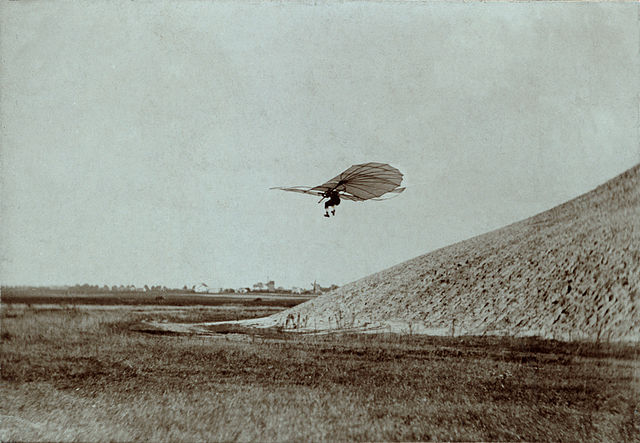
When we think about important figures in the history of aviation, Orville and Wilbur Wright obviously spring to mind. However, they probably wouldn’t have been able to fly without the work of Otto Lilienthal, a German aviator, who was known as the flying man. Lilienthal wasn’t the first person to build heavier than air flying machines, and he wasn’t the first person to fly, but he was vital for many other reasons. In fact, in 1912, Wilbur Wright said, “Of all the men who attacked the flying problem in the 19th century, Otto Lilienthal was easily the most important.”
Lilienthal was born in Germany (Prussia) in 1848. He and his brother were fascinated by birds and flight from a young age and they made wings to try and fly while they were at school. When he finished school, he became a professional engineer, but his fascination with flying continued. In the late 1860s, he and his brother started to analyze the aerodynamics of birds and to make gliders. He built a 15m high hill to test his designs and made over 2,500 glider flights. The hill is still there and is now a monument to his life. Unfortunately, in 1896, when he was only 48 years old, his glider was caught in a wind and he crashed and died.
Otto Lilienthal did several things that make him invaluable to the history of flight. Let’s look at them.
The first thing is his scientific work on the aerodynamics of wings. People had made gliders for over a hundred years before Lilienthal started his work. George Cayley had worked out the main four forces that governed how any flying machine would fly: thrust, lift, drag, and weight and he had made some gliders that flew, but he had never flown in one of his gliders. Lilienthal brought a very scientific approach to the problem and started to look at the shapes of the wings. He used a whirling arm, which was a device with wings fitted to the sides and weights. When wind was forced over it, the weights would move, and he could calculate the air pressure over and under the wing for different wing shapes.
He spent over 15 years conducting this research. There was a theory that curved wings were better for flight than flat wings, but nobody knew why. His experiments proved this to be true and they showed that the air pressure is different with a curved wing than it is with a flat wing. In 1889, he published his research in a book called Der Vogelflug als Grundlage der Fliegekunst (Birdflight as the Basis of Aviation). The Wright brothers, and many other aviators, used this book as the foundation for their research and experiments into powered flight. Without Lilienthal’s research, powered flight would have taken far longer to materialize.
The second invaluable thing Lilienthal did was to show that heavier than air flight was possible and respectable. After he had completed his research and experimentation, Lilienthal started to test it. He built himself a 15 m hill, constructed a series of gliders, and started to make flights to test his concepts. He made over 2,000 flights over the next seven years and his farthest flight was 300 m long. Each time he landed, he made notes on what went right, what went wrong, and he modified his designs. He made eight different types of gliders with different sized wings and different materials. However, the fact that he made them is not as important as the fact that he flew them. He put faith into his designs, and he jumped off a 15 m hill.
Lilienthal’s experiments and his flights attracted attention. Newspapers had only recently started using photographs, and Lilienthal’s flights were very photogenic. Pictures of him went global. His efforts increased research into flying because he showed people that it was possible. He not only built heavier than air flying machines, he showed that they could carry people. He publicized this new field of flight and got more people interested in it. He showed that experimentation and constant refinement was the way to go. And, he showed that respectable people could do an activity like this. Before him, there had been an impression that people who tried to fly were cranks or crazies. Lilienthal put a stop to that way of thinking.
So, when we fly in an airplane, one of the giant’s shoulders that we are standing upon is that of Otto Lilienthal. He carried out experiments on the aerodynamics of wings, publishing his research in a book that pushed the aviation industry forward. And he publicized the new field of aviation, while showing that it was respectable at the same time. And this is what I learned today.
Image By Unknown author – This image is available from the United States Library of Congress's Prints and Photographs divisionunder the digital ID ppmsca.02546.This tag does not indicate the copyright status of the attached work. A normal copyright tag is still required. See Commons:Licensing., Public Domain, https://commons.wikimedia.org/w/index.php?curid=16106043
Sources
https://www.atlasobscura.com/places/fliegeberg
https://britishheritage.com/history/sir-george-cayley-aviation
https://lemelson.mit.edu/resources/otto-lilienthal
https://airandspace.si.edu/collection-objects/lilienthal-glider/nasm_A19060001000
https://invention.psychology.msstate.edu/i/Lilienthal/Lilienthal.html
https://www.grc.nasa.gov/www/k-12/UEET/StudentSite/historyofflight.html
https://www.brookfieldav.com/single-post/2017/05/26/legends-of-aviation-3-otto-lilienthal
https://en.wikipedia.org/wiki/Otto_Lilienthal
https://www.lilienthal-museum.de/olma/eotto.htm
https://www.lilienthal-museum.de/olma/e34.htm
